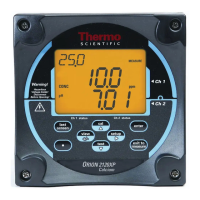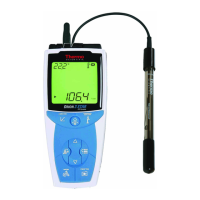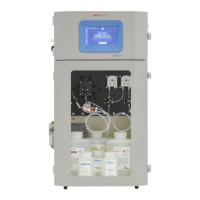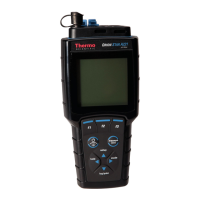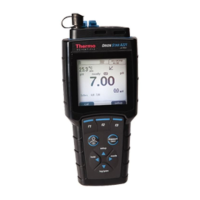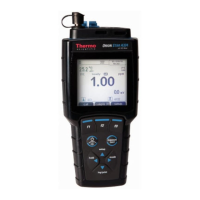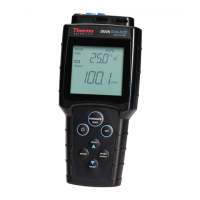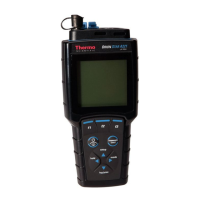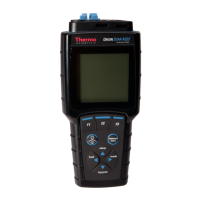Do you have a question about the Thermo Scientific Orion 2230XP and is the answer not in the manual?
Guidelines and warnings for safe operation and handling of the analyzer.
Details on power requirements, connection types, safety class, and fuses.
Specifies operating and storage temperature ranges, humidity, and altitude limits.
Defines parameters for sample inlet pressure, flow rate, temperature, and fittings.
Instructions for removing the analyzer from its packaging and inspecting for damage.
Step-by-step guide for initial setup and powering on the analyzer.
Overview of the analyzer's capabilities, design, and intended use.
Description of the analyzer's control panel, keypad, and display.
Explanation of the information shown on the analyzer's display fields.
Details on navigating menus, including item indicators and key functions.
How the analyzer displays current readings, units, date, and time in measurement mode.
Explanation of the colorimetric method used for silica analysis.
Recommendations for storing reagents and standards safely.
Information about the specific calibration standard used for this analyzer.
Details on the reagents needed for operation and their installation.
Estimates for reagent usage and lifespan based on analysis frequency.
Guidelines for physically installing the analyzer, including weight and clearance.
Instructions for connecting sample inlet, return, and drain lines.
Procedure for replacing or installing the pump head tubing.
Steps for correctly inserting reagent bottles into the analyzer.
Safety precautions and procedures for connecting the analyzer to electrical power.
Details on configuring and connecting the analog output signals.
Information on connecting alarm inputs and understanding relay outputs.
Wiring details for external control inputs and sensor connections.
Instructions for establishing communication links with the analyzer.
Procedure for performing a manual calibration cycle and accepting results.
How the analyzer handles calibration results outside specified tolerances.
Steps to activate the analyzer for routine, unattended operation.
How to check calibration accuracy using a validation function.
Procedure to perform a single or multiple sample analyses on demand.
Description of the different operational modes like sample analysis and calibration.
Comparison of sample analysis and validation cycles and their data handling.
Methods for executing manual or automatic calibration cycles.
Procedures for performing automatic or manual cleaning of the reaction cell.
Configuration of post-measurement wash cycles to clean the reaction cell.
Steps for priming instrument lines to fill tubing and purge air.
Overview of the analyzer's optical components and calibration process.
Detailed steps for performing optics calibration, including prerequisites.
Procedure for calibrating the reaction cell's temperature control system.
Instructions for tuning and calibrating the thermistor and heater assembly.
Explanation of peristaltic pump function and the need for calibration.
Step-by-step guide for calibrating the individual pumps for accurate dosing.
Procedure for calibrating the analog output channels for signal accuracy.
Fundamental principles behind calibration using standards and calibration curves.
Description of available calibration methods: Single Point and Base Line.
Details on performing single point calibration and its formula.
Explanation of base line calibration for improved low-level measurement accuracy.
Procedure for calibrating the dilution factor for high concentration samples.
Principles of measuring sample concentration based on absorbance.
Explanation of the AUTO restart and MANUAL restart modes of operation.
How the analyzer automatically restarts measurements after idle periods.
Procedure for initiating measurements manually and standby operation.
Sequence of events performed during a single analysis cycle.
Details on the cell wash step, including volume adjustment.
Description of the sample capture step and settling time.
Procedure for checking the optical path and LED source status.
Testing the reaction cell temperature against the set point.
Recording the blank absorbance reading before reagent addition.
Procedure for adding reagents and editing reagent volumes.
Final reading and absorbance measurement for concentration calculation.
Configuring post-measurement wash cycles to clean the reaction cell.
Steps for priming instrument lines to fill tubing and purge air.
How measurement and calibration results are stored and retrieved.
Instructions for printing stored measurement results via RS-232 port.
Configuring instrument functionality, operational parameters, and display settings.
Performing manual analysis, calibration, validation, and cleaning cycles.
Reviewing collected data, alarms, and faults from recent cycles.
System administration, hardware setup, fluidics priming, and diagnostics.
Configuration of alarm parameters and assignment of alarms to faults.
Mapping multiple alarms to individual output relays.
Configuration and settings for the instrument's analog output signals.
Configuration of internal and external inputs for sensors and control.
Adjusting display settings like contrast, backlight, and font size.
Setting calibration parameters, including reference and current values.
Configuration of validation parameters, sources, and repetition counts.
Setting instrument mode, frequency, units, and wash cycle parameters.
Configuration of parameters for manual or periodic cleaning cycles.
Selection of temperature display units (Fahrenheit or Celsius).
Configuring method parameters and the order of analysis events.
Setting and editing the instrument's current date and time.
Configuration for daylight saving time adjustments.
Settings for instrument behavior after a power interruption.
Configuration settings for network connectivity via Ethernet.
Setting the baud rate for serial communication.
Selection of the instrument's operating language.
Initiates a single manual analysis cycle.
Initiates a manual calibration cycle using standard solutions.
Performs manual validation of the instrument with a known sample or standard.
Initiates manual cleaning of the reaction cell.
Review and reset instrument faults and alarms.
Review and print stored calibration results from the database.
Review and print stored analysis results from the database.
Deletes the entire calibration results database.
Deletes the entire analysis results database.
Manage user access, passwords, and permissions for the instrument.
Access to hardware calibration and configuration settings.
Procedure for priming the analyzer's fluidic lines.
Tools for testing individual components like pumps, valves, and optics.
Allows editing of user names, passwords, and permissions.
Allows deletion of user accounts from the system.
Allows adding new user accounts with specific permissions.
Restore factory defaults or update instrument settings.
View instrument details like software version, serial, and model numbers.
Allows modification of the analysis label displayed on the instrument.
Configure settings for printing system and parameter reports.
Calibrating the thermistor for accurate reaction cell temperature measurement.
Calibrating the flow rate of the peristaltic pumps.
Calibrating the analyzer's optical system for accurate readings.
Calibrating the analog output signals for proper data transmission.
Fine-tuning previously calibrated hardware values.
Runs an automatic priming sequence for all fluid lines.
Selectively prime specific fluid sources like sample or reagents.
Adjusting the volume of fluid used during the priming process.
Setting the blank value for newly installed reagents.
Checking the functionality of pumps, valves, and the stirrer.
Checking the status of external inputs and assigned functions.
Directing analyzer operation via external controller using digital inputs.
Validates a sample without sending results to analog outputs.
Checking the functionality of the instrument's relays.
Checking the functionality of the two analog output channels.
Testing optics functionality, adjusting LED intensity and detector gain.
Information on default passwords and procedures for forgotten ones.
Hierarchical overview of the analyzer's menu structure and navigation.
Definitions for alarm types, values, and hysteresis.
Definitions for relay modes and capabilities.
Definitions for analog output types, low, and high concentration values.
Definitions for external input labels, events, and actions.
Definitions for display settings like contrast and backlight time.
Definitions for calibration parameters like standard, mode, and slope.
Definitions for validation parameters like source and number of repeats.
Definitions for analysis parameters like mode, frequency, and units.
Definitions for cleaner parameters like source, volume, and flow rate.
Definitions for temperature unit selection.
Definitions for method parameters like cell wash and wavelength.
Definitions for selectable date formats.
Definitions for selectable time formats.
Definitions for power failure duration and clean cycle settings.
Definitions for IP address and server settings.
Definitions for baud rate settings.
Definitions for instrument language selection.
Definitions for reviewing and resetting alarms and faults.
Definitions for displaying and printing calibration results.
Definitions for displaying and printing analysis results.
Definition for deleting the entire calibration database.
Definition for deleting the entire analysis database.
Definitions for editing user names, passwords, and permissions.
Definition for deleting a user account.
Definition for adding a new user account.
Definitions for instrument details like software version and serial number.
Definition for changing the instrument's label name.
Definitions for printing system and parameter configurations.
Definitions for adjusting calibrated values for pumps, optics, and gain.
Definitions for priming volume settings.
Definitions for checking functionality of pumps, valves, and stirrer.
Definition for checking the functionality of relays.
Definitions for testing analog output channels.
Definitions for testing LEDs, intensity, and amplifier gain.
Procedure for safely changing reagent bottles and entering new blank values.
Instructions for replacing pump head tubing using the maintenance kit.
Steps for cleaning the reaction cell to maintain performance and accuracy.
Recipes for preparing standard and extra strength cleaning solutions.
Procedure for inspecting and cleaning the sample flow chamber.
How to put the system into standby or perform an extended shutdown.
Introduction to the analyzer's modes of operation for power plant applications.
Analyzer automatically restarts measurements after idle time.
Analyzer waits for operator command to start or resume measurements.
Analyzer performs periodic house-keeping routines while in standby mode.
Recommended setup for operating the analyzer in an on-demand mode.
Statements regarding radio frequency energy and compliance with FCC rules.
Manufacturer's declaration of compliance with safety and EMC standards.
Details on warranty periods, exclusions, and limitations for the instrument.
Procedures for making warranty claims, returns, and adjustments.
Information on ordering consumables and recommended product usage.
Contact information for technical support and authorized dealers.
| Brand | Thermo Scientific |
|---|---|
| Model | Orion 2230XP |
| Category | Measuring Instruments |
| Language | English |
